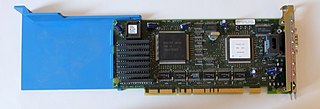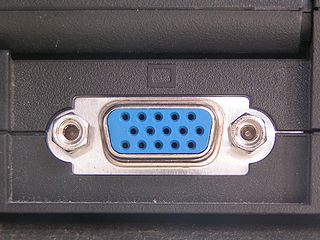
IBM 8514 is a graphics card manufactured by IBM and introduced with the IBM PS/2 line of personal computers in 1987. It supports a display resolution of 1024 × 768 pixels with 256 colors at 43.5 Hz (interlaced), or 640 × 480 at 60 Hz (non-interlaced). 8514 usually refers to the display controller hardware. However, IBM sold the companion CRT monitor which carries the same designation, 8514.

VESA, formally known as Video Electronics Standards Association, is an American technical standards organization for computer display standards. The organization was incorporated in California in July 1989 and has its office in San Jose. It claims a membership of over 300 companies.
VESA BIOS Extensions (VBE) is a VESA standard, currently at version 3, that defines the interface that can be used by software to access compliant video boards at high resolutions and bit depths. This is opposed to the "traditional" INT 10h BIOS calls, which are limited to resolutions of 640×480 pixels with 16 colour (4-bit) depth or less. VBE is made available through the video card's BIOS, which installs during boot up some interrupt vectors that point to itself.
Computer display standards are a combination of aspect ratio, display size, display resolution, color depth, and refresh rate. They are associated with specific expansion cards, video connectors, and monitors. These standards encompass various aspects of the display, including resolution, refresh rate, color depth, and connectivity.

Video Graphics Array (VGA) is a video display controller and accompanying de facto graphics standard, first introduced with the IBM PS/2 line of computers in 1987, which became ubiquitous in the IBM PC compatible industry within three years. The term can now refer to the computer display standard, the 15-pin D-subminiature VGA connector, or the 640 × 480 resolution characteristic of the VGA hardware.

A graphics card is a computer expansion card that generates a feed of graphics output to a display device such as a monitor. Graphics cards are sometimes called discrete or dedicated graphics cards to emphasize their distinction to integrated graphics processor on the motherboard or the CPU. A graphics processing unit (GPU) that performs the necessary computations is the main component in a graphics card, but the acronym "GPU" is sometimes also used to erroneously refer to the graphics card as a whole.

Micro Channel architecture, or the Micro Channel bus, is a proprietary 16- or 32-bit parallel computer bus introduced by IBM in 1987 which was used on PS/2 and other computers until the mid-1990s. Its name is commonly abbreviated as "MCA", although not by IBM. In IBM products, it superseded the ISA bus and was itself subsequently superseded by the PCI bus architecture.

The Enhanced Graphics Adapter (EGA) is an IBM PC graphics adapter and de facto computer display standard from 1984 that superseded the CGA standard introduced with the original IBM PC, and was itself superseded by the VGA standard in 1987. In addition to the original EGA card manufactured by IBM, many compatible third-party cards were manufactured, and EGA graphics modes continued to be supported by VGA and later standards.

The Video Graphics Array (VGA) connector is a standard connector used for computer video output. Originating with the 1987 IBM PS/2 and its VGA graphics system, the 15-pin connector went on to become ubiquitous on PCs, as well as many monitors, projectors and high-definition television sets.

Texas Instruments Graphics Architecture (TIGA) is a graphics interface standard created by Texas Instruments that defined the software interface to graphics processors. Using this standard, any software written for TIGA should work correctly on a TIGA-compliant graphics interface card.

Video BIOS is the BIOS of a graphics card in a computer. It initializes the graphics card at the computer's boot time. It also implements INT 10h interrupt and VESA BIOS Extensions (VBE) for basic text and videomode output before a specific video driver is loaded. In UEFI 2.x systems, the INT 10h and the VBE are replaced by the UEFI GOP.
Parallels Workstation is the first commercial software product released by Parallels, Inc., a developer of desktop and server virtualization software. The Workstation software comprises a virtual machine suite for Intel x86-compatible computers which allows the simultaneous creation and execution of multiple x86 virtual computers. They distributed the product as a download package. Parallels Workstation has been discontinued for Windows and Linux as of 2013.
Extended Video Graphics Array is a standard created by VESA in 1991 denoting a non-interlaced resolution of 1024x768 at a maximum of 70 Hz refresh rate.

The Borland Graphics Interface, also known as BGI, was a graphics library bundled with several Borland compilers for the DOS operating systems since 1987. BGI was also used to provide graphics for many other Borland products including the Quattro Pro spreadsheet.
The ATI Mach line was a series of 2D graphics accelerators for personal computers developed by ATI Technologies. It became an extension to the ATI Wonder series of cards. The first chip in the series was the ATI Mach8. It was essentially a clone of the IBM 8514/A with a few notable extensions such as Crystal fonts. Being one of the first graphics accelerator chips on the market, the Mach8 did not have an integrated VGA core. In order to use the first Mach8 coprocessor cards, a separate VGA card was required. This increased the cost of ownership as one had to purchase two rather than one expansion card for graphics. A temporary solution was presented with the ATI Graphics Ultra/Vantage cards, which combined an ATI 8514 Ultra and VGA Wonder+ into a single card. The Mach32 chip was the follow-up to the Mach8, which finally featured an integrated VGA core, true colour support and a 64-bit datapath to internal memory.
A multiple-sync (multisync) monitor, also known as a multiscan or multimode monitor, is a raster-scan analog video monitor that can properly synchronise with multiple horizontal and vertical scan rates. In contrast, fixed frequency monitors can only synchronise with a specific set of scan rates. They are generally used for computer displays, but sometimes for television, and the terminology is mostly applied to CRT displays although the concept applies to other technologies.

VGA text mode was introduced in 1987 by IBM as part of the VGA standard for its IBM PS/2 computers. Its use on IBM PC compatibles was widespread through the 1990s and persists today for some applications on modern computers. The main features of VGA text mode are colored characters and their background, blinking, various shapes of the cursor, and loadable fonts. The Linux console traditionally uses hardware VGA text modes, and the Win32 console environment has an ability to switch the screen to text mode for some text window sizes.
Video Seven, Inc., also typeset as Video-7, later Headland Technology, Inc., was a public American computer hardware company independently active from 1984 to 1989. The company manufactured expansion cards for personal computers, mainly graphics cards for the IBM PC through their Vega brand. It was founded by Paul Jain as his second venture in the graphics card market; after his departure in 1990, he founded Media Vision. Video Seven delivered both the first graphics card compatible with IBM's Enhanced Graphics Adapter (EGA), in 1985, and one of the first cards compatible with IBM's Video Graphics Array (VGA) standard, in 1987. In 1989, Video Seven merged with G-2 Inc., a subsidiary of LSI Logic Corporation, becoming Headland Technology.
Genoa Systems Corporation, later Genoa Electronics Corporation, was an American computer multimedia peripheral vendor based in San Jose, California, and active from 1984 to 2002. The company was once a prolific and well-known manufacturer of video cards and chipsets. They also dabbled in modems, tape drives, sound cards, and other peripheral expansion cards. The company was a founding member of the Video Electronics Standards Association (VESA) and were instrumental in the development of Super VGA.



















